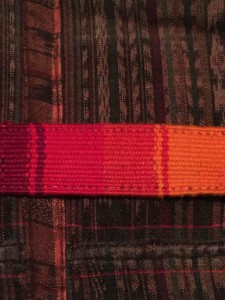The Uses of Propaganda
The Uses of Propaganda
Whoever holds the power tells the story. Propaganda is a tool for seizing and preserving control. Slant information in service of your point of view, even if the facts are no longer recognizable.
When I went to Guatemala in September 1992, I was arrested and accused of stealing the baby I had come to adopt. That story was told to further several agendas: to undo the adoption, preserve the status quo in Guatemala’s orphanage system, and divert attention from the children who had been stolen by the Guatemalan military.
Although my prison stay was short, the other inmates tested their power over me with visual propaganda.
As soon as I was alone in the lower prison yard by the pay phones, the nearest group of women rose from the rough concrete benches along the perimeter and surrounded me, pressing close. Hands stroked my arms, fondled my hair. All I could see were the thick keloid scars on their cheeks. The shortest woman, the one who had declared her love for me the past two nights at lockdown, put her arm around my waist. I dropped my head as she jerked me close and shook the newsprint tabloid they’d been sharing in my face. The ink was smudged from being passed from hand to hand. Black and white photographs of dead female bodies, naked and mutilated, filled the page. Only the eyes were hidden by black censor’s bars. Fear hummed in my empty belly at a new, lower octave. I twisted out of her grip. The women cackled and hooted as they parted their circle to let me pass.
Those images invaded my thoughts for weeks after my release. Even now they are too-easily recalled. Years later, I learned that the government favored snuff porn tabloids as a coercive tool during the war. Graphic photographs of atrocities reminded civilians of what could happen to enemies of the state.
Given my experience, I read with skepticism about ¡GuateAmala!, a project undertaken in 2004 by the world-renowned designer and author Bruce Mau at the request of the Guatemalan government. A few months ago, Mau received the Philadelphia Museum of Art’s 2015 Design Excellence Award; his work for Guatemala is part of a current exhibition, Work on What You Love: Bruce Mau Rethinking Design.
Last week, I went to the museum to challenge what I saw as an attempt to glorify propaganda. When I approached the Perelman Building, a sense of trespass slowed my steps. I imagined being silenced for my private complaints. By the time I entered the Collab Gallery that housed the installation, I was holding my breath. Guatemala still has the power to unnerve me.
On the left was a bright wall of books designed by Mau; on the right, a list of the 43 points in his Incomplete Manifesto for Growth. On another day, his design for the Panamarama Gallery in the Biomuseo in Panama would have held my attention, but I was distracted by the upbeat tone of the designer’s voice a few feet away discussing Guatemala. Alone at the back of the gallery, I planted my feet before the monitor showing a short film about !GuateAmala! and dared Mau to erase the legacy of a thirty-six year civil war and my own harsh memories with two exclamation points and an extra “A.”
The bright colors and happy faces in the video and accompanying posters disarmed me. The shy optimist in my nature slipped up next to the cynic. I had to watch the full loop several times before I was settled enough to absorb the message.
Mau translated the slogan ¡GuateAmala! to mean “The Love of Guatemala,” or “For the Love of Guatemala.” He spoke of creating “a culture of life after so many years of war and a culture of death.” He said “Guatemalans had lost the ability to dream,” and so he worked with them to “build a practice of dreams by showing what was already happening, providing tools for change, and connecting the world to Guatemala.” Together they were “building a movement for the next generation.”
The project culminated with an outdoor event. One of Guatemala City’s traffic circles was transformed into a brightly colored enclosure where Guatemalans gathered to celebrate their values and leave behind their individual written commitments to the country’s future. My heart plummeted at the sight of the decorated roundabout. That circle, or one very much like it, was the gathering place for the street children who tried to sell me dying roses on the Sunday evening I arrived in Guatemala. What I had remembered for so long as half-hidden by evening shadows stood draped in vivid colors beneath a cloudless blue sky. Time had not stood still in Guatemala. Part of the wall behind my sternum crumbled.
The third of Mau’s 43 Manifesto points states that “Process is more important than outcome.” That may be, but I couldn’t help asking myself after visiting the exhibit how, or even if, the results of ¡GuateAmala!, for Guatemalans, had been measured. Their country is still unstable, struggling with crime and corruption. Then I remembered that three weeks ago, on January 14, Guatemala inaugurated a new president, Jimmy Morales. His election was due in part to the use of social media to organize political action. A new social movement is forming under #EstoApenasEmpieza (This is Just the Beginning).
This December will mark the twentieth anniversary of the war’s official end. The post-war generation is coming of age. May the street children who once sold roses to survive be among them.

